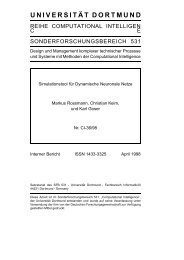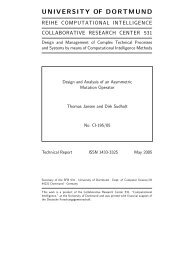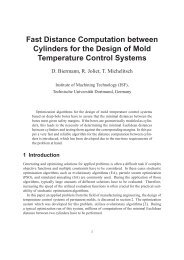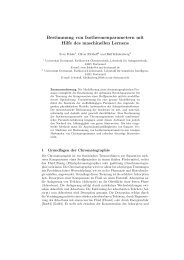Self-Adaptive Genetic Algorithms with Simulated Binary Crossover
Self-Adaptive Genetic Algorithms with Simulated Binary Crossover
Self-Adaptive Genetic Algorithms with Simulated Binary Crossover
Create successful ePaper yourself
Turn your PDF publications into a flip-book with our unique Google optimized e-Paper software.
Deb, K. and Agrawal, R. B. (1995) <strong>Simulated</strong> binary crossover for continuous search space. Complex<br />
Systems, 9 115–148.<br />
Deb, K. and Goyal, M. (1998). A robust optimization procedure for mechanical component design based<br />
on genetic adaptive search. Transactions of the ASME: Journal of Mechanical Design, 120(2), 162–<br />
164.<br />
Deb, K., and Goyal. M. (1996). A combined genetic adaptive search (GeneAS) for engineering design.<br />
Computer Science and Informatics, 26(4), 30–45.<br />
Deb, K. and Kumar, A. (1995). Real-coded genetic algorithms <strong>with</strong> simulated binary crossover: Studies<br />
on multi-modal and multi-objective problems. Complex Systems, 9(6), 431–454.<br />
Eshelman, L. J. and Schaffer, J. D. (1993). Real-coded genetic algorithms and interval schemata. In D.<br />
Whitley (Ed.), Foundations of <strong>Genetic</strong> <strong>Algorithms</strong>, II (pp. 187–202).<br />
Fogel, L. J., Angeline, P. J., and Fogel, D. B. (1995). An evolutionary programming approach to selfadaptation<br />
on finite state machines. In J. R. McDonnell, R. G. Reynolds, and D. B. Fogel (Eds.)<br />
Proceedings of the Fourth International Conference on Evolutionary Programming, 355–365.<br />
Goldberg, D. E. (1991). Real-coded genetic algorithms, virtual alphabets, and blocking. Complex Systems,<br />
5(2), 139–168. (Also IlliGAL Report 90001)<br />
Goldberg, D. E., Deb, K., and Clark, J. H. (1992). <strong>Genetic</strong> algorithms, noise, and the sizing of populations.<br />
Complex Systems, 6, 333–362.<br />
Goldberg, D. E., Korb, B., and Deb, K. (1989). Messy genetic algorithms: Motivation, analysis, and first<br />
results, Complex Systems, 3, 93–530.<br />
Gordon, V. S. and Whitley, D. (1993). Serial and parallel genetic algorithms as function optimizers.<br />
In S. Forrest (Ed.), Proceedings of the Fifth International Conference on <strong>Genetic</strong> <strong>Algorithms</strong> (pp.<br />
177–183).<br />
Grünz, L. and Beyer, H.-G. (in press). Some observations on the interaction of recombination and selfadaptation<br />
in evolution strategies. Proceedings of the Congress on Evolutionary Computation.<br />
Hansen, N. and Ostermeier, A. (October, 1998). Personal communication.<br />
Hansen, N. and Ostermeier, A. (1996). Adapting arbitrary normal mutation distributions in evolution<br />
strageties: The covariance matrix adaptation. Proceedings of the IEEE International Conference on<br />
Evolutionary Computation, 312–317.<br />
Hansen, N. and Ostermeier, A. (1997). Convergence properties of evolution strategies <strong>with</strong> the derandomized<br />
covariance matrix adaptation: The (=I;)-CMA-ES. European Congress on Intelligent<br />
Techniques and Soft Computing, 650–654.<br />
Harik, G. (1997). Learning gene linkage to efficiently solve problems of bounded difficulty using genetic<br />
algorithms (IlliGAL Report No. 97005). Urbana: University of Illinois at Urbana-Champaign,<br />
Illinois <strong>Genetic</strong> <strong>Algorithms</strong> Laboratory.<br />
Herdy, M. (1992). Reproductive isolation as strategy parameter in hierarchically organized evolution<br />
stretegies. In R. Männer and B. Manderick (Eds.) Parallel Problem Solving from Nature, II, 207–<br />
217.<br />
Johnson, N. L. and Kotz, S. (1970). Continuous univariate distributions—1, Boston: Houghton Mifflin.<br />
23








